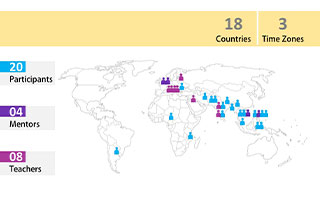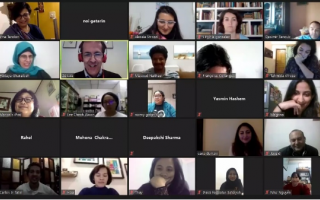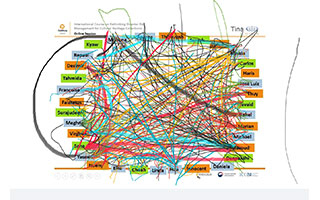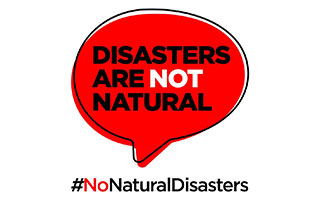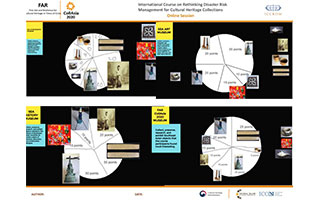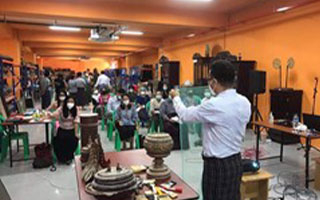ICCROM’s First Aid and Resilience and CollAsia programmes join forces to bring ideas to action through online collaborative learning.
As the COVID-19 pandemic continues to disrupt everyday life, ICCROM's International Course on Rethinking Disaster Risk Management for Cultural Heritage Collections has provided a window of opportunity to rethink training and develop capacities.
ICCROM, in close collaboration with Cultural Heritage Administration (CHA) of the Republic of Korea, the Escuela Taller de Filipinas Foundation Inc, Philippines, and the International Council of Museums (ICOM), developed this course consisting of online collaborative learning and in-person activities using a fully interactive training module.
Two programmes of ICCROM – CollAsia and First Aid and Resilience in Times of Crisis (FAR) – have shared resources to organize this course for professionals working with heritage collections in the Asia-Pacific region, an area of the world greatly affected by climate change-induced extreme weather events. Twenty participants working with movable heritage will be empowered through the training design, supported by four mentors and eight teachers. The mentors and teachers were drawn from the FAR alumni network and have different professional backgrounds ranging from the culture sector, humanitarian assistance, and disaster risk management.
Tailored to diverse institutional contexts, the course targets the enhancement of the participants' ability to reduce disaster risk for their respective collections and develop functional multi-hazard, disaster risk management plans.
“The lectures and exercises from this international training have inspired me to take immediate actions towards creating national as well as institutional disaster risk management plans, following the theoretical framework provided in the course.” — Kyaw Shin Naung, Myanmar
The International Course on Rethinking Disaster Risk Management for Cultural Heritage Collections is being conducted in three phases:
- Two-week online learning session – a first of its kind remote session held across two weeks in December 2020.
- One-week in-person, hands-on training is tentatively scheduled to take place at the Escuela Taller de Filipinas Foundation Inc, in Manila, Philippines, in June, COVID-19 recommendations permitting.
- Three-month post-training projects – development and implementation of disaster risk management plans and procedures in the participants' respective institutions with mentoring support.
Building an online community of practice
While using online learning to connect people and effect change on the ground was a challenge, the project team took it as a window of opportunity to innovate and implement a human-centred design. This course focused on building an online community, overcoming the obstacle of inter-communication and one-on-one social engagement while working across three time zones, using virtual platforms and tools.
The online training sessions are designed in a step-by-step format to develop a well-coordinated, context-specific, and fully functional disaster risk management plan. Through short and concise 30-minute presentations, the teachers expanded on steps taken, the requirements fulfilled, capacities built, and awareness to be raised, to facilitate such a plan in their
institutions. The case examples shared by the teaching team made this remote training more relatable for the participants, as also expressed by Faizzatus Sa’diyah, from Indonesia:
“Linda Lainvoo’s presentation and shared knowledge on establishing a close relationship with the actors and building a network was inspiring, as many such tips and tricks based on her experience can be adapted to our contexts.”
Training features
The sessions have been delivered through the Zoom platform, facilitating both individual and group exercises, ensuring that each participant grasped the knowledge imparted. Course materials, assignments and submissions were made and distributed through user-friendly virtual cloud drives. Virtual tools provided a designated platform for a coherent workspace, enabling participants to work together in their assigned groups.
The global COVID-19 pandemic has made specific communities and their heritage more vulnerable to multiple-hazards. To tailor the content to realities on the ground, scenario-based learning highlighting the need for integrated strategies was used. A variety of activities such as interactive games, quizzes, online group work, role-play, multiple-choice questionnaires to enhance the understanding of critical concepts and issues were used.
Source: United Nations Office for Disaster Risk Reduction.
“The concepts were not that easy at first, but the lecturers made sure that participants grasp them at the end of every session. Examples were generously given that made it more comprehensible.” — Marian de Leon, Philippines
To foster a sense of a “community” and create a strong network, the course team went beyond the usual training programme by introducing a daily virtual activity to provide support and reassurance. This exercise consisted of forming personal connections through cultural exchange using various mediums. While some participants showed a glimpse of their everyday lives, homes and views, others presented their cultural institutions and workspaces, forming closer ties. Additionally, almost all sessions were periodically recapped, and learning activities were interspersed with meditation or stretching exercises.
“I was able to connect well, especially with fellow participants from my country, Indonesia. We shared resources and ideas while helping each other understand a topic and overcome difficulties. With other learners in different countries, we were able to exchange information on various museum collections” — Faizzatus Sa'diyah, Indonesia
Bridging gaps in virtual training
The FAR-CollAsia team has ensured that every participant is attended to and considered with regards to accessibility and a smoother learning transition. With a wide geographical spread, the limited internet connection was a challenge faced on many occasions. Therefore, the team has ensured that each activity, lesson, and discussion is recorded and made available for everyone involved. Every session has concluded with mentor evaluations and collective reflections concerning their mentees to better analyze their expectations following the day's experience—further informal debates and discussions conducted over virtual coffee sessions post-lessons. The course's online training phase terminated with positive participant feedback on their learning experiences, specific to each lesson, activity, and simulation covered through online survey forms.
“Regardless of a limited internet connectivity on certain occasions, I never felt frustrated with keeping up with the course. The facilitators ensured that the materials and recordings were easily available and accessible, as well as sufficient to keep us on track. Additionally, every time I missed an important discussion, mentors and fellow participants were always supportive.” — Marian de Leon, Philippines
And the learning continues
The course is currently in the post-training mentoring phase as the participants develop each step of a functional disaster risk management plan in their institutions and updating the existing ones in their countries. Mentors and teachers periodically review their work through scheduled presentations and online group meetings.
Following the online training phase and despite the limited resources available and pandemic restrictions, participants could initiate significant connections with relevant stakeholders in their local context. They have also successfully gathered the missing links to formulate a working disaster risk management plan such as data related to their buildings, climate, and hazard profiles of their countries. One of the success stories was of a participant from Myanmar, who shared his knowledge gained with a local private museum. He has also received further interest from various governmental and non-governmental institutions for a similar training programme, hence initiating a community of practice through the broader application of the lessons learnt from this International Course on Rethinking Disaster Risk Management for Cultural Heritage Collections.
Article by:
Hedaya Gharaibeh, Intern – FAR Programme, ICCROM
Mohona Chakraburtty, Course Coordinator – FAR CollAsia, ICCROM
Jui Ambani, Consultant – FAR Programme, ICCROM

